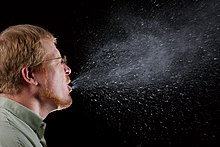
Back رذاذ تنفسي Arabic Papaian pahinakan BJN Goteta de Flügge Catalan Gotas de Flügge Spanish Piisknakkus Estonian قطره تنفسی Persian Gouttelette respiratoire French Pinga respiratoria Galician נתז נשימתי HE Goutlèt respiratwa HT

A respiratory droplet is a small aqueous droplet produced by exhalation, consisting of saliva or mucus and other matter derived from respiratory tract surfaces. Respiratory droplets are produced naturally as a result of breathing, speaking, sneezing, coughing, or vomiting, so they are always present in our breath, but speaking and coughing increase their number.[1][2][3]
Droplet sizes range from < 1 μm to 1000 μm,[1][2] and in typical breath there are around 100 droplets per litre of breath. So for a breathing rate of 10 litres per minute this means roughly 1000 droplets per minute, the vast majority of which are a few micrometres across or smaller.[1][2] As these droplets are suspended in air, they are all by definition aerosols. However, large droplets (larger than about 100 μm, but depending on conditions) rapidly fall to the ground or another surface and so are only briefly suspended, while droplets much smaller than 100 μm (which is most of them) fall only slowly and so form aerosols with lifetimes of minutes or more, or at intermediate size, may initially travel like aerosols but at a distance fall to the ground like droplets ("jet riders").[4]
These droplets can contain infectious bacterial cells or virus particles they are important factors in the transmission of respiratory diseases. In some cases, in the study of disease transmission a distinction between what are called "respiratory droplets" and what are called "aerosols" is made, with only larger droplets referred to as "respiratory droplets" and smaller ones referred to as "aerosols" but this arbitrary distinction has never been supported experimentally or theoretically,[5][3] and is not consistent with the standard definition of an aerosol.
- ^ a b c Johnson, G.R.; Morawska, L.; Ristovski, Z.D.; Hargreaves, M.; Mengersen, K.; Chao, C.Y.H.; Wan, M.P.; Li, Y.; Xie, X.; Katoshevski, D.; Corbett, S. (2011-12-01). "Modality of human expired aerosol size distributions". Journal of Aerosol Science. 42 (12): 839–851. Bibcode:2011JAerS..42..839J. doi:10.1016/j.jaerosci.2011.07.009. ISSN 0021-8502.
- ^ a b c Gregson, Florence K. A.; Watson, Natalie A.; Orton, Christopher M.; Haddrell, Allen E.; McCarthy, Lauren P.; Finnie, Thomas J. R.; Gent, Nick; Donaldson, Gavin. C.; Shah, Pallav L.; Calder, James D.; Bzdek, Bryan R. (2021-02-26). "Comparing aerosol concentrations and particle size distributions generated by singing, speaking and breathing". Aerosol Science and Technology. 55 (6): 681–691. Bibcode:2021AerST..55..681G. doi:10.1080/02786826.2021.1883544. hdl:10044/1/87506. ISSN 0278-6826. S2CID 233353106.
- ^ a b Bourouiba, Lydia (2021-01-05). "The Fluid Dynamics of Disease Transmission". Annual Review of Fluid Mechanics. 53 (1): 473–508. Bibcode:2021AnRFM..53..473B. doi:10.1146/annurev-fluid-060220-113712. ISSN 0066-4189. S2CID 225114407.
- ^ Hunziker, Patrick (2021-10-01). "Minimising exposure to respiratory droplets, 'jet riders' and aerosols in air-conditioned hospital rooms by a 'Shield-and-Sink' strategy". BMJ Open. 11 (10): e047772. doi:10.1136/bmjopen-2020-047772. ISSN 2044-6055. PMC 8520596. PMID 34642190.
- ^ Wilson, Nick; Corbett, Stephen; Tovey, Euan (2020). "Airborne transmission of Covid-19". BMJ. 370: m3206. doi:10.1136/bmj.m3206. ISSN 1756-1833. PMID 32819961. S2CID 221178291.